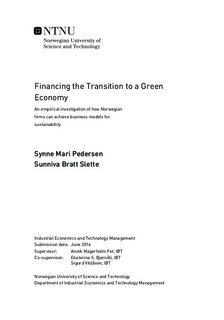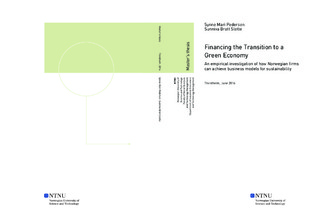| dc.description.abstract | The objective of this Master s thesis is to explore the interaction between the state of the current financial system and sustainable value creation of companies. This is done by examining how the financial community and business actors can address tensions that currently provide barriers for sustainability investments. The thesis is structured as an exploratory case study within the context of Norwegian industry development in the transition to a green economy. More specifically, the study investigates how a Norwegian Green Investment Bank (GIB) could incorporate sustainability in investment decisions with the mission to facilitate a transition to business models that are more sustainable.
With this objective the thesis addresses a gap in corporate sustainability literature, where less attention has been devoted to the financial aspects of the tensions used to characterize sustainability. This gap is also valid for the emerging business model literature, which is often found to have a normative approach to sustainability. Our contriution is to look at tensions that describe the financial characteristics in companies quest to become truly sustainable, using the business model view as our theoretical lense. The thesis thus explores which tensions related to financial characteristics that provide the most substantial barriers for the development and implementation of business models for sustainability. Tensions are used to provide a theoretical context to describe issues related to short-termism versus long-termism, conflicts of organizational change in the financial system, along with weaknesses of the business model view. We contribute directly to the literature by expanding the integrative tensions framework of Hahn et al. (2015) and include a new tension termed Stakeholder significance . The tension describes firms limited resources in the task to address stakeholders in corporate communication and business model innovation.
The thesis is structured to describe and discuss the financial characteristics of business model innovation, communication and financial evaluation methods. Findings show that since business actors hold the power to innovate and upscale business models for sustainability, they also have a responsibility to incorporate ESG values in their strategies. A strong ESG focus implies that the firms have a futureproof strategy and have consciously addressed risks beyond the direct financial risks. Furthermore, we identfied a gap in the Norwegian public funding system and capital market in what is termed the valley death , in the phase between conceptualization and commercialization on the technology maturity scale. Tied to this, there is a need for investments in business model innovations that promote market creation over incremental efficiency and performance improvements.
Improved communication and interaction can bridge the current gap for sustainable investments between the financial community and business. Additionally, sustainability communication could help companies to align their efforts and lift businesses that fulfil the SDGs and climate targets. Through our analysis of the countless sustainability initiatives that exist for internal and external communication, we found that companies have a wide range of tools to improve their sustainability. Yet, it is mostly large, established firms that deploy these measures, compared to SMEs who do not posess the same resources. As a result of the empirical analysis, along with the expansion of the tensions framework, the findings suggest materiality as a solution to the identified challenges related to greenwashing and death by reporting . In addition, materiality can be a good starting point for identifying and devoting resources to key sustainability issues.
Financial evaluation methods are essential to accelerate sustainable development in industries. One of the most important findings across all three areas of business model innovation, communication and financial evaluation methods, is the call for standardized KPIs that can incorporate ESG factors for comparison between investors and companies. The power to channel investment flows gives financial institutions a responsibility to consider the impact of their investments on relevant stakeholders, including the society and environment. Hence, investors should take considerations of both financial and ESG values into investment decisions. Active ownership becomes increasingly important for investors to reduce climate-related risks, for instance by the inclusion of firms that score high in sustainability rankings and divestment from firms that lag behind.
Lastly, findings indicate that interaction between the financial community and business has the potential to address tensions related to sustainability, and that a Green Investment Bank could function as an intermediary. The GIB could accelerate the implementation of standardized KPI s, ESG metrics and a long-term investment horizon. Findings clearly indicate that the Norwegian industry would benefit from a GIB to mitigate risks and attract private capital for sustainability investments. The need for a GIB was especially large in the valley of death. The GIB was recommended to have an international scope, to promote industry development and enhance business model innovation. Furthermore, it could be configured to provide a resolution strategy to the intertemporal tension by reinforcing a long-term perspective in investment decisions. It can also respond to the tensions related to change, by offering risk mitigating financial instruments as a venture capital investor. A more practically oriented discussion of the GIB s role in the Norwegian market can be found in the separate report called Establishing a Green Investment Bank, found in Appendix A.
As an exploratory case study, the thesis prepares the ground for further research. A logical next step could be to adopt a more pragmatic perspctive, quantify the connections between the financial system and business that promotes sustainability, and assess implications of the proposed new tension related to stakeholder significance. | |

